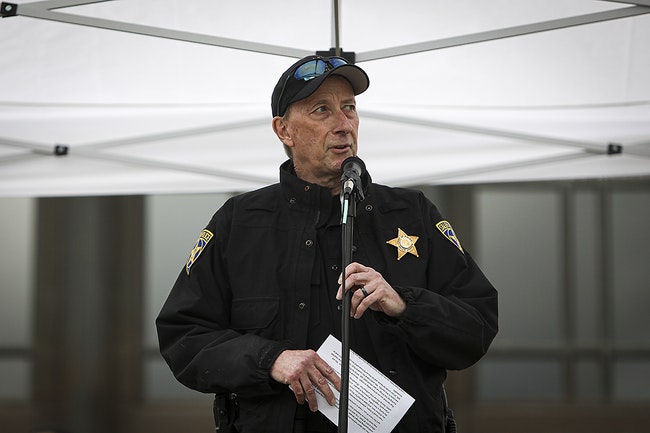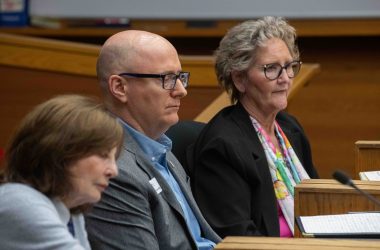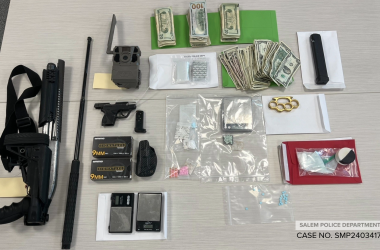 Jerry Moore, Salem police chief, addresses protesters at the March for Floyd proceedings at the Capitol on Saturday, June 6. Moore was among the first speakers for an event that stretched on for hours. (Amanda Loman/Salem Reporter)
Jerry Moore, Salem police chief, addresses protesters at the March for Floyd proceedings at the Capitol on Saturday, June 6. Moore was among the first speakers for an event that stretched on for hours. (Amanda Loman/Salem Reporter)
Salem Police Chief Jerry Moore released an extraordinary review of police actions that occurred a month ago when protests erupted in downtown Salem after the police killing of George Floyd in Minneapolis.
The public review, released Monday, was a first for the retiring chief who has been in law enforcement for 43 years.
“We pretty much bared our soul on this one,” Moore told the Salem Reporter Monday.
The 10-page review details the escalating situation during three nights of protests in late May and early June and the decision-making that led to police actions such as tear gassing protesters for the first time in Salem Police Department history.
Moore said the unsparing review done by his staff “gave us an opportunity to let the community know these things are not easy.”
The Salem City Council called for the review at its June 8 meeting. Councilor Matt Ausec specifically wanted to know about the handling of an incident outside Glamour Salon on June 1 in which a Salem police officer is recorded on camera telling a group of heavily armed militia members they needed to discretely remain in the building or in their cars to avoid violating a city curfew.
DOCUMENT LINK: Salem Police Department review
The video gained national attention and Moore has spoken publicly about the incident on several occasions. In the June 24 review, he said some of the officers “words or actions” created a belief the city was supporting the militia’s efforts.
The review focused on the presence of militia figures, noting that “the militia group that came into the city created even more challenges.”
“It is ironic that a group that has created multiple issues around the state and has made repeated disparaging comments toward law enforcement and elected officials would end up causing us to be on the defensive for how we tried to control the situation,” the report said.
The report said the “armed militia” that appeared in town to protect Glamour Salon “created a clear safety concern for our community.”
Police worked to keep the militia and Black Lives Matter protesters separated, “making every effort to deescalate tense situations.”
Dealing with the militia who took up a position on the sidewalk outside the Glamour Salon was meant to keep the risks down.
“The department did not make a bad situation worse with the armed militia who have repeatedly made threats to law enforcement and the government,” the report said. “The Salem Police Department, as an organization, did not and does not side with the militia.”
On Monday, he told Salem Reporter that officers could have been better briefed on the citywide curfew, which prohibited travel on any public street, sidewalk or public place. He said even people in their cars would be violating the curfew.
In the review, Moore said attempts to de-escalate the situation with militia members doesn’t mean officers are white supremacists — a criticism that has been hurled online — and that officers’ approach appears to be successful because no one was arrested simply for violating the curfew.
“It is unfortunate there are not more videos circulating that show our officers shaking hands with all groups who were talking to us or offering us their hand. It is unfortunate there are not more videos circulating of us telling all people we met, who were not engaged in active hostilities toward us, to please get off the street, into a business or into their vehicles. These events did take place,” Moore wrote.
He told Salem Reporter that police were facing multiple objectives on some nights, like keeping protesters and armed militia members from fighting while also doing traffic control.
“The most important thing is we look at did we make the right decisions? Should we allow the protesters to go anywhere they wanted? Should we not have impeded them? Did we create a situation where there was an opportunity for negative reaction with the police?” Moore said. “We weigh that against if our team had made difference decisions, you might have been asking different questions: Why did you allow them to get into violent confrontations? Why did you allow them to loot?”
On Monday, Moore said the department’s main takeaway from the process is to coordinate with organizers ahead of planned events, unlike two nights of protests.
In the review, the police department self-critiques for each night of the protests, listing what it could’ve done differently.
In one of the review’s critiques, it said Deputy Chief Skip Miller chose not to send police to a peaceful protest Sunday out of concern their presence would inflame the situation.
“The delayed deployment of our [mobile response team], in hindsight, may have been the wrong decision as it allowed more time for people to engage in unlawful activity. Deploying the team earlier may have resolved the situation sooner,” the review said.
Such public criticism of an agency subordinate is highly unusual.
Moore also told Salem Reporter his department is considering training additional officers in crowd control, a 40-hour training. Currently about 30 officers are specifically trained to handle crowds, Lt. Treven Upkes said.
In the review, Moore described officers who were physically exhausted with not enough time to prepare, the inability to call for backup from other agencies or to fully brief officers on the conditions of the newly imposed curfew on Saturday, May 30.
“In all our years as a city, we have never encountered this type of widespread behavior in such a short period of time. We provided repeated verbal warnings for people to leave the area, yet people remained with the intent to engage in illegal activities, including attempts to assault police officers,” Moore said in the review.
Upkes said about eight officers helped craft the review, which summarizes a timeline of protesters blocking the Marion Street Bridge, a clash between protesters and militia members and protesters spraying graffiti at the Capitol.
Moore said the department received its harshest criticism for using tear gas and other munitions on the crowd of “peaceful protesters.” He said those protesters were launching items at officers that damaged officers’ boots and car tires. Moore also said protesters were wearing gas masks and brought milk to help wash out tear gas from their eyes.
Moore said in other times, Salem police would have been able to call on agencies like the Oregon State Police to help, but they were busy assisting in Portland, where protests have been much larger.
“In this case we couldn’t go help anybody and nobody could come help us,” he said.
When asked if the review has been a learning process for the department, Moore said “This whole month has been a learning process for us.”
SUPPORT ESSENTIAL REPORTING FOR SALEM – A subscription starts at $5 a month for around-the-clock access to stories and email alerts sent directly to you. Your support matters. Go HERE.
Have a story tip? Contact reporter Saphara Harrell at 503-549-6250, [email protected] or @daisysaphara.









